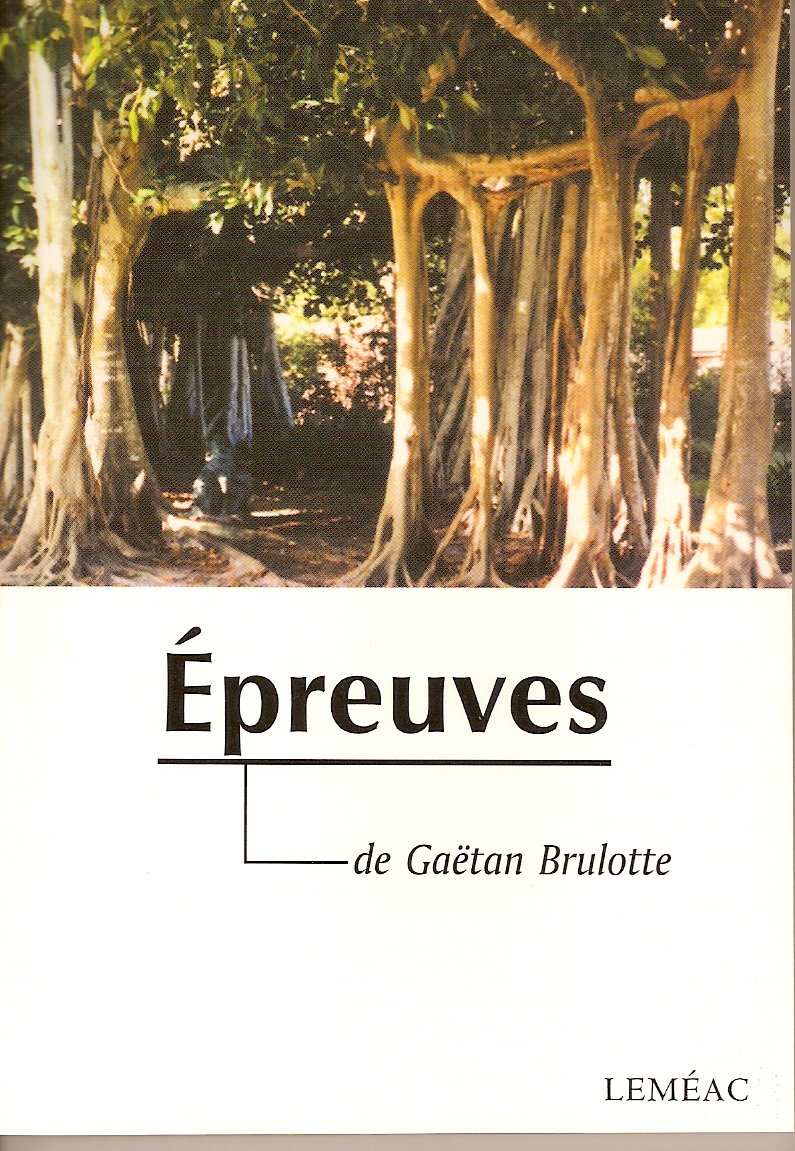To the Test
 Short stories (Montreal, Leméac, 1999, 104p.)
Short stories (Montreal, Leméac, 1999, 104p.)
This is a collection of five short stories in which all the characters are submitted to some form of testing and where they also try to test the world around them. But the main component put to test here is the reader, since these stories are completely unconventional and experimental in their writing. Obviously the author is trying to explore new ways of telling stories.
Reviews' excerpts
"Stands as a prowess," writes Reginald Martel, adding a bit disconcerted," how can one pass these tests?" Réginald Martel, Montreal, La Presse May 23, 1999, p. B-4
"To put the genre to the test. That is the enterprise of Gaetan Brulotte who practices a crossbreeding of genres in his small book titled To the Test. The act of mixing narratives forms in short story writing (...) gives to the genre an enlarged dimension, which is semantically and formally rich of possibilities, and which allows the writer to get out of the limited frame of short story." Claudine Potvin, Montreal, Lettres québécoises 97 (Spring 2000): 38-39.
"In all, five ways of seeing the creative writing process, which is in the likeness of the Banyan tree, "this tree which is a forest by itself." Pierre Karch, Littéralité [Toronto] XI.2, Fall-Winter 1999, p. 113.
"None of these stories has a conventional format, each text exploring the possibilities of mixing discourses and genres (…). For instance, the first narrative, "Legends of a photo album" proposes 32 commentaries of pictures of writer Serge Gravier, from age 8 to his fifties, when he mysteriously disappeared. This remarkable fragmented narrative creates the illusion of life in its movement and ruptures, as well as gives an idea of the feeling of dispossession and powerlessness of this man who witnesses his own changes of face, of shape, while living throughout his life much anxiety and dissatisfaction. "The Audition", the longest short story of the collection, also has the most baroque form of all Brulotte's short stories. (…) The subject is as complex as its form. (…) The ending is dramatically surprising. In "The Side Rack Truck", the format seems at first sight traditional. The first parts presents a description of a jolly farewell of a young man to his bachelor's life: covered with molasses with feathers and flour glued on top of him, he is forced to get drunk and to appear in front of her fiancée in that horrifying and degraded state. The second part returns to formal plays with the fiancée's fragmented thoughts, among others, which are dismembered on the page, as they reflect the disorder of the grotesque scene. Then a sensational turn of events in the usual Brulotte's style: a great misfortune happens that makes life cruel and absurd. "The Time sculptor", if it has the appearance of a traditional narrative, is nevertheless a hybrid text mixing narrative, philosophy and aesthetics and developing the strange ideas of an artist who seeks to master the art of "Non-Act". This baroque short story summarizes in a breathtaking manner the life of this man who is finishing a monumental sculpture, an iron banyan tree, in which he will be buried. Far from all the usual literary tricks (or playing joyfully with them), Brulotte marks a renewal in the conception and the evolution of the short story as a genre with this collection." Michel Lord, UTQ University of Toronto Quarterly - Volume 70 Number 1, Winter 2000/01.
"The result is unique in Quebec literature.(…) The mixing of genres, the total absorption of other discourses, the carnival atmosphere, the parody of an array of styles (portrait, description, lyricism, drama, philosophy…) clearly show Brulotte's rich way of renewing the genre of short stories exploiting different sources, and pushing it to unimaginable frontiers."
"Michel Lord, "Epreuves de Gaëtan Brulotte: la nouvelle comme genre phagocytaire", Littératures "La Nouvelle québécoise contemporaine", 52 (2005) (Presses Universitaires du Mirail, Fr.) : 139.